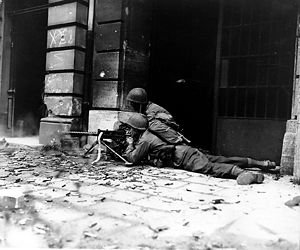Battle of Aachen
|
||||||||||||||||||||||||||||||
|
||||||||||||||||||||||||||||||
|
||||||||||||||||||||||||||||||
The Battle of Aachen was a battle in Aachen, Germany, that took place in October 1944 in World War II. At the time of this battle, there were only about 20,000 civilians living there; the remainder of the 160,000 inhabitants (1939 census) had been evacuated by German commander Gerhard von Schwerin to protect them from Allied attacks. When von Schwerin contemplated surrender to protect the city's artifacts from air raids, Hitler had him removed. Hitler then sent about 5,000 Volkssturm to bolster the city's defences, the defence now being led by Gerhard Wilck.

Contents |
Background
The American commanders decided to besiege the city and cut it off from supply and other essentials. However, the Germans had a different view. The city was important in German history, being the coronation site of Charlemagne, and the home of the Holy Roman Empire (later called Holy Roman Empire of the German Nation), or what Hitler deemed the "First Reich." Moreover, this was the first major German city to face invasion, so Hitler ordered that the city be held at all costs. Hitler deemed that "it was necessary to hold the line at Aachen in order to ensure the survival of the Third Reich." [1]
Battle
Meanwhile, the Ninth United States Army had been maneuvering north and south of the city, but eventually realizing that the Aachen garrison was a potential threat, the commanders decided to take the city directly. Once within the city they faced murderous urban warfare, advantageous to the Germans who were on their own ground and knew the city well. The American troops in the hardest fighting included the 2nd and 3rd Battalions of the 18th and 26th Infantry Regiments of the 1st Division, supported by the U.S. 745th Tank Battalion. From the north, the 30th Division attacked as well.
Captain James M. Burt, company commander of B Company 66th Armor Regiment of the 2nd Armored Division, was awarded the Medal of Honor for his heroism during the battle.
The 30th Division took more than 2,000 casualties in a matter of days, and elements of the 29th Division were forced to join the fight. Eventually, the city was taken at a cost of 5,000 casualties on both sides, with an additional 5,600 Germans taken prisoner.
Aftermath
Franz Oppenhoff was appointed by the Allies as the new Mayor of Aachen, but he was soon shot by German Commandos sent on special orders from Hitler.
References
- ↑ Zaloga, J Steven (2007). The Siegfried Line 1944-45 (Battles on the German frontier). Osprey Publishing. pp. pg 25.
- Rass, Christoph; Rohrkamp, René; Quadflieg, Peter M., General Graf von Schwerin und das Kriegsende in Aachen. Ereignis, Mythos, Analyse, Aachen 2007. ISBN 978-3-8322-6623-3.
